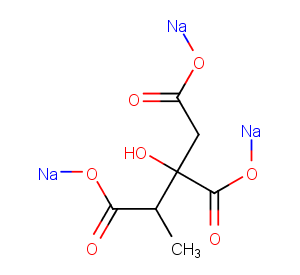Powder: -20°C for 3 years | In solvent: -80°C for 1 year


2-Methylcitric acid trisodium (Methylcitric acid) is an endogenous metabolite in the 2-methylcitric acid cycle. It accumulates in methylmalonic and propionic acidemias.

| Description | 2-Methylcitric acid trisodium (Methylcitric acid) is an endogenous metabolite in the 2-methylcitric acid cycle. It accumulates in methylmalonic and propionic acidemias. |
| In vitro | 2-Methylcitric acid impairs glutamate metabolism and induces permeability transition in brain mitochondria. It inhibits glutamate dehydrogenase (GDH) activity at concentrations as low as 0.5 mM. 2-Methylcitric acid (1-3 mM; 150 seconds) provokes a significant decrease in mitochondrial membrane potential and induced swelling in Ca2+-loaded mitochondria supported by different substrates. 2-Methylcitric acid behaves as a potent inhibitor of glutamate oxidation by inhibiting glutamate dehydrogenase activity and as a permeability transition inducer, disturbing mitochondrial energy homeostasis. 2-Methylcitric acid does not significantly impair mitochondrial glutamate transport. 2-Methylcitric acid does not significantly impair glutamate mitochondrial transport in liver mitochondria. |
| Synonyms | Methylcitric acid trisodium |
| Molecular Weight | 229.14 |
| Formula | C7H10NaO7 |
| CAS No. | 117041-96-0 |
Powder: -20°C for 3 years | In solvent: -80°C for 1 year
You can also refer to dose conversion for different animals. More
bottom
Please see Inhibitor Handling Instructions for more frequently ask questions. Topics include: how to prepare stock solutions, how to store products, and cautions on cell-based assays & animal experiments, etc.
2-Methylcitric acid trisodium 117041-96-0 Others Methylcitric acid Methylcitric acid trisodium 2-Methylcitric acid 2Methylcitric acid trisodium 2 Methylcitric acid trisodium inhibitor inhibit
